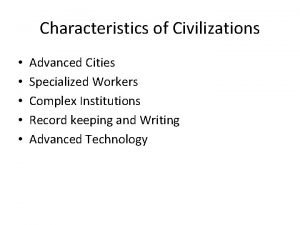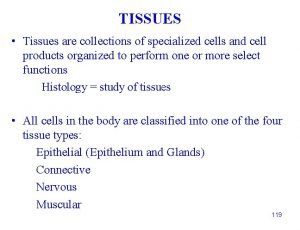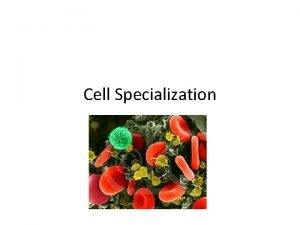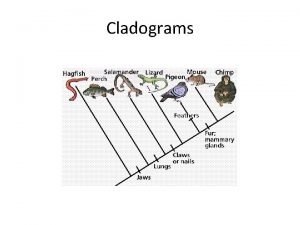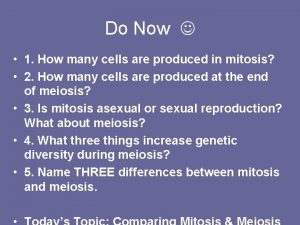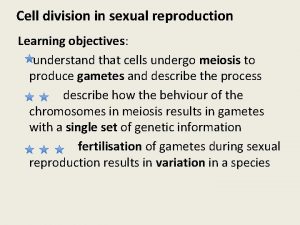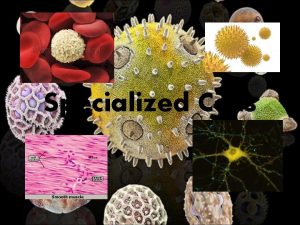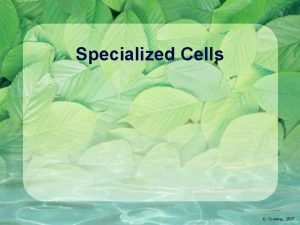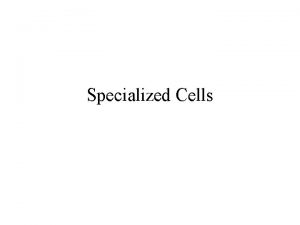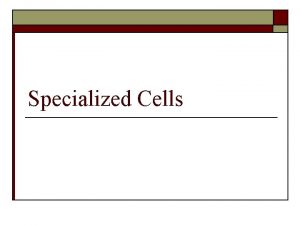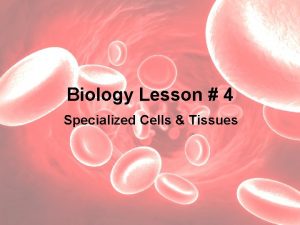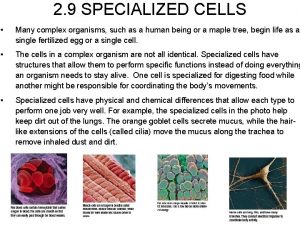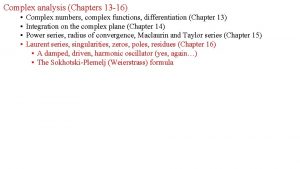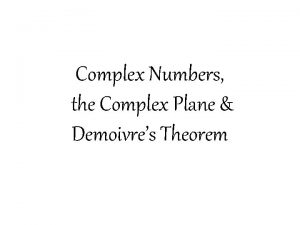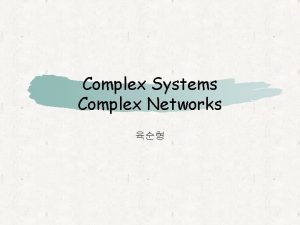1 6 Specialized Cells SPECIALIZED CELLS Many complex






























- Slides: 30

1. 6 – Specialized Cells

SPECIALIZED CELLS Many complex organisms, such as a human being or a maple tree, begin life as a single fertilized egg or a single cell. The cells in a complex organism are not all identical. They have been created to perform specific functions, such as digesting food, fighting disease, or coordinating the body’s movements.

SPECIALIZED CELLS Specialized cells have physical and chemical differences that allow each type to perform one job very well. For example, the specialized cells in the picture help keep dirt out of the lungs. The orange goblet cells secrete mucus, while the hair-like extensions of the cells (called cilia) move the mucus along the trachea to remove inhaled dust and dirt.

SPECIALIZED CELLS Many complex organisms, such as a human being or a maple tree, begin life as a single fertilized egg or a single cell.

SPECIALIZED CELLS Plant cells also have a variety of specialized cells. Cells in the leaf of a tree have a different structure and function from the cells in the trunk. Notice from the pictures below the different functions of various plant cells.

How do these cells Specialize? Cell specialization is influenced by what is found in an organism’s cell cytoplasm and environmental factors Ø Such as: temperature, cell death, diseases, and secretions from neighboring cells

Where do these specialized cells come from? Plant Cells Meristematic cells are the first (1 n) cell to develop unspecialized in plants (meaning no specific name, function, etc. ) These later develop into specialized cells for plants

Where do these specialized cells come from? Animal Cells Stem Cells are the first (1 n) cell to develop unspecialized in animals These later develop into specialized cells for animals

Case Study: Stem Cells Since stem cells have the ability to repair and replace damaged cells They are often used for medial treatments v transplants (of bone marrow) for cancer patients v “banked” placenta from embryonic birth The way in which stem cells are used for various treatments tends to raise some ethical concerns

Case Study: Stem Cells https: //www. youtube. com/watch? v=ev. H 0 I 7 Co c 54 (4)

Case Study: Stem Cells

Case Study: Stem Cells Two types of stem cells: 1. Embryonic / pluripotent: differentiate into any kind of cell obtained from unused embryos from IVF problematic for the Catholic Church


Case Study: Stem Cells Two types of stem cells: 2. Adult or tissue-specific: only in specialized tissue only able to differentiate into certain types of cells i. e. adult stem cells in bone marrow only form white and red blood cells, platelets

Case Study: Stem Cells Umbilical cord blood is a rich source of stem cells These stem cells can develop into various kinds of blood cells Cord blood can be stored for use later in the child’s or a sibling’s life.

LOOKING BACK KEY CONCEPTS SUMMARY All organisms are made up of one or more cells. The cell theory states that the cell is the basic unit of life, that all organisms are made up of one or more cells, and that all cells come from pre-existing cells. Single-celled organisms, such as bacteria, consist of just one cell. Every plant and animal, including humans, is a multicellular organism and is classified as a eukaryote.

LOOKING BACK KEY CONCEPTS SUMMARY Microscopes enable us to examine cells in detail. Plant and animal cells have most of the major cell structures in common. Materials for cell activity pass through the cell membrane by diffusion and osmosis. Plant cells contain a cell wall, a large central vacuole, and chloroplasts. Cells grow and divide to replace worn-out cells, to allow for growth in organisms, to repair damaged cells, and to reproduce.

LOOKING BACK KEY CONCEPTS SUMMARY The cell cycle occurs in distinct stages. The cell cycle has three stages: interphase, mitosis, and cytokinesis. Interphase is the stage when cells grow, perform their specific functions, produce more organelles, and replicate their DNA. Mitosis is the division of the DNA in a cell’s nucleus. Cytokinesis is the division of the entire cell into two new identical daughter cells.

LOOKING BACK KEY CONCEPTS SUMMARY Cell division is important for growth, repair, and reproduction. Mitosis and cytokinesis together make up the cell division portion of the cell cycle. Mitosis results in each daughter cell receiving an exact copy of the parent cell’s DNA. Cells go through four phases during mitosis: prophase, metaphase, and telophase (PMAT).

LOOKING BACK KEY CONCEPTS SUMMARY Cancer cells generally divide more rapidly than normal cells. Cancer is a broad group of diseases in which groups of cells grow and divide uncontrollably. Uncontrolled cell growth and division create a mass of cells that may form a tumour. A benign tumour does not seriously affect nearby cells and does not spread through the body. A malignant tumour is made up of cancer cells; it may invade and damage surrounding tissues. Cancer cells can metastasize to other parts of the body. Prevention and screening minimize the risk of cancer.

LOOKING BACK KEY CONCEPTS SUMMARY Medical imaging technologies are important in diagnosing and treating disease. Screening sometimes involves imaging technologies Medical imaging technologies include endoscopy, X-ray, ultrasound, CT scanning, and MRI. Imaging technologies are widely used diagnostic tools that aid in the detection of cancer and other diseases. Microscopic examination of cells is the only way to confirm a diagnosis of cancer.

Review M/C Questions

QUIZ MULTIPLE CHOICE For each question, select the best answer from the four alternatives. 1. Cells must perform certain basic activities to stay alive. Those activities are performed by (a)bacterium (b)organelles (c) eukaryotes (d)diffusion 2. Why do cells divide? (a)so that they can reproduce (b)so that they can grow (c) so that they can repair damage (d)all of the above

CHAPTER 2 QUIZ ANSWERS MULTIPLE CHOICE 1. Cells must perform certain basic activities to stay alive. Those activities are performed by (a) bacterium (b) organelles (c) eukaryotes (d) diffusion 2. Why do cells divide? (a) so that they can reproduce (b) so that they can grow (c) so that they can repair damage (d) all of the above

QUIZ 3. When single-cell organisms divide, only one parent is involved. What is the name of this process? (a) osmosis (b) sexual reproduction (c) diffusion (d) asexual reproduction 4. Which one is not a phase of mitosis? (a) prophase (b) centrophase (c) metaphase (d) anaphase

CHAPTER 2 QUIZ ANSWERS 3. When single-cell organisms divide, only one parent is involved. What is the name of this process? (a) osmosis (b) sexual reproduction (c) diffusion (d) asexual reproduction 4. Which one is not a phase of mitosis? (a) prophase (b) centrophase (c) metaphase (d) anaphase

QUIZ FILL IN THE BLANKS Copy each of the following statements into a notebook. Fill in the blanks with a term from the box below that correctly completes the sentence. benign; daughter cells; plant cells; malignant; mutation; cancer cells 5. ______ divide more rapidly than normal cells. 6. Only _______ have chloroplasts. 7. In the cytokinesis phase, the cytoplasm divides and two identical _______ are produced. 8. Uncontrolled cell growth may create a mass of cells that form a lump or tumour. Tumours may be ______ or ______. 9. _______ refers to random changes in a cell’s DNA.

CHAPTER 2 QUIZ ANSWERS FILL IN THE BLANKS 5. Cancer cells divide more rapidly than normal cells. 6. Only plant cells have chloroplasts. 7. In the cytokinesis phase, the cytoplasm divides and two identical daughter cells are produced. 8. Uncontrolled cell growth may create a mass of cells that form a lump or tumour. Tumours may be benign or malignant. 9. Mutation is a term that refers to random changes in a cell’s DNA.

CHAPTER 2 QUIZ SHORT ANSWER 10. In your notebook, write which of the three stages of the cell cycle correspond to the letters in the diagram. Then describe what occurs during each of the stages. B C A

CHAPTER 2 QUIZ ANSWERS SHORT ANSWER 10. (a) Interphase is the stage when the cell carries out all life activities except division. (b) Mitosis is the stage when the contents of the nucleus divides. (c) Cytokinesis is the stage when the remainder of the cell—the cytoplasm, organelles, and cell membrane—divides.
 Advanced cities and specialized workers
Advanced cities and specialized workers Collections of specialized cells and cell products
Collections of specialized cells and cell products Specialized cells in animals
Specialized cells in animals Specialized cells
Specialized cells Bruno dislikes sitting on the beach
Bruno dislikes sitting on the beach Ghon complex
Ghon complex Simple and compound sentences quiz
Simple and compound sentences quiz Oedipus complex and electra complex
Oedipus complex and electra complex Sigmund freud psychoanalytic theory
Sigmund freud psychoanalytic theory Sublimation in psychology
Sublimation in psychology Onodi cells and haller cells
Onodi cells and haller cells Tubular reabsorption
Tubular reabsorption Pineal gland
Pineal gland Somatic cells vs gametes
Somatic cells vs gametes Somatic cells vs germ cells
Somatic cells vs germ cells Chlorocruorin
Chlorocruorin Prokaryotic vs eukaryotic cells
Prokaryotic vs eukaryotic cells Plant cell animal cell venn diagram
Plant cell animal cell venn diagram Prokaryotic cells vs eukaryotic cells venn diagram
Prokaryotic cells vs eukaryotic cells venn diagram Cell organelle jeopardy
Cell organelle jeopardy Masses of cells form and steal nutrients from healthy cells
Masses of cells form and steal nutrients from healthy cells Younger cells cuboidal older cells flattened
Younger cells cuboidal older cells flattened Are plant cells prokaryotic or eukaryotic
Are plant cells prokaryotic or eukaryotic Is a staphylococcus cell prokaryotic or eukaryotic
Is a staphylococcus cell prokaryotic or eukaryotic Nondisjunction in meiosis
Nondisjunction in meiosis Cell substance
Cell substance Slugs have hair
Slugs have hair How many cells are in a swot matrix
How many cells are in a swot matrix How many cells are produced in meiosis? *
How many cells are produced in meiosis? * How many cells
How many cells Number of chromosomes in meiosis
Number of chromosomes in meiosis
